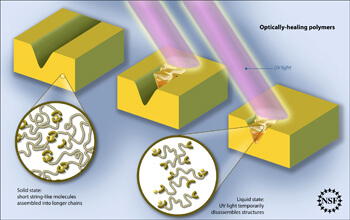The material, known as "metallo-supramolecular polymers", is able to become a flexible liquid that fills cracks and gaps created by scratches or abrasion and then turns back into a solid within a minute after being exposed to ultraviolet light

A team of researchers from the USA and Switzerland has developed a polymer-based material capable of repairing itself when exposed to light. The material, known as "metallo-supramolecular polymers", is able to become a flexible liquid that fills cracks and gaps created by scratches or abrasion and then turns back into a solid within a minute after being exposed to ultraviolet light.
"This is revolutionary and ingenious materials research," said Andrew Lovinger, a scientist in the Materials Division at the US National Science Foundation. "It demonstrates the power of the ability of innovative polymeric materials to successfully address technological issues and contribute to society while developing a variety of applicable scientific ideas."
The researchers envision widespread uses of the developed repair materials, even in the near future, mainly as coatings for consumer products such as cars, floors and furniture. Although their polymers are not yet ready for commercial use, they have proven that this idea does work.
The new materials were created using a well-known mechanism known as "supramolecular assembly". Unlike normal polymers, which consist of long, chain-like molecules with thousands of atoms, the innovative material consists of small molecules that build longer, polymer-like chains, using metal ions as "molecular glue" to prepare the innovative polymers.
Although these polymers behave similarly to ordinary polymers, when they are irradiated by powerful ultraviolet light the complex structures temporarily become separate. This ability turns the material that was originally solid into a liquid that is able to flow easily. When the light irradiation is turned off, the material is rebuilt and solidifies again; Its original features are restored.
Using the same lamps that dentists use to fill holes in teeth, the researchers were able to repair scratches in their polymers. In those places that the lamp shone on, the scratches were filled with the material and disappeared, similar to a cut in the skin of the ice cream without leaving any marks on the skin, and that in just a few seconds. Tests by the researchers showed that the material does not lose its ability after repeated repairs - they showed that the scratch can be repaired with the material in the same place over and over again.
Moreover, although it has been known for a long time that even heat can be the means of self-repair of materials, the use of light provides notable advantages, explains one of the researchers. "Through the use of light, we have a higher level of control since we are able to tune only towards the defect and leave the rest of the material intact."
The researchers systematically tested several new polymers in order to find the best combination of mechanical properties and repairability. They found that metal ions that initiate the assembly process through weak chemical bonds function best as light-labeled molecular glue. The research findings were published in the prestigious scientific journal Nature.
Demo Video

3 תגובות
Nice stuff…
I wonder at what light intensity it melts? Because it may simply melt from the sun...
Stunning…
It's funny to think that except for Star Trek (literally of course)... almost everything else that was described in this series and also things that they haven't even imagined yet become a reality or already a reality in our time.